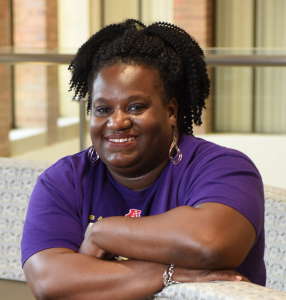 When Krystal Joshua, age 34, learned she was pregnant in July 2016, she told friends and family not to plan a baby shower. Though she and her husband were overjoyed about her pregnancy, Krystal worried that her chances for delivering a healthy, full-term baby were slim.
When Krystal Joshua, age 34, learned she was pregnant in July 2016, she told friends and family not to plan a baby shower. Though she and her husband were overjoyed about her pregnancy, Krystal worried that her chances for delivering a healthy, full-term baby were slim.
After two stillbirths more than 10 years ago and, in 2015, a miscarriage that required a trip to the operating room for emergency surgery and a blood transfusion, Krystal wanted her baby in her arms before celebrating.
She didn’t have far to turn for support and expert care. Krystal is a front-desk receptionist in the Department of Obstetrics and Gynecology at MedStar Montgomery Medical Center. “Dr. Jayaraj reassured me that everything would be fine with this pregnancy,” recalls Krystal. “She said, ‘Don’t worry, I will deliver a healthy baby for you.’”
Thirty-five percent of all pregnancies delivered at MedStar Montgomery are considered high-risk, according to Sujithra Jayaraj, MD, a board-certified obstetrician and gynecologist in the Department of Obstetrics and Gynecology. “We have a lot of high-risk pregnancies, and we dedicate a lot of time as a team to managing them,” says Dr. Jayaraj.
“Our first challenge was to get Krystal safely through the first 12 weeks of pregnancy,” explains Dr. Jayaraj.
What followed for Krystal was a carefully choreographed care plan to ensure that she met each of her pregnancy milestones and didn’t get discouraged. Krystal faced many challenges, including contractions that started at 18 weeks and a blood clot in her placenta, the structure that nourishes the baby. By 28 weeks, Dr. Jayaraj had ordered complete bed rest for Krystal.
Given Krystal’s health issues, two major challenges for Krystal’s delivery required painstaking consideration by Dr. Jayaraj. “We had to regroup to think about how to limit the baby’s exposure to anesthesia and how to prevent the potential for life-threatening bleeding for Krystal.”
When Krystal experienced regular contractions at 34 weeks, Dr. Jayaraj decided, with Krystal’s agreement, to use only a local anesthetic initially for her C-section. General anesthesia was administered at the last moment, just before reaching the baby, when Krystal began to feel pain. “We kept the baby’s exposure to anesthesia to less than 20 seconds,” Dr. Jayaraj recalls. “And, with blood products preordered and on hand, we quickly controlled Krystal’s anticipated blood loss.” More than 15 nurses and doctors participated in the delivery.
“Our small community hospital gives everyone the confidence that we can manage care for patients like Krystal just as larger hospitals can,” says Dr. Jayaraj.
Krystal encourages other women she meets who may have high-risk pregnancies not to give up hope. “I tell them to come to MedStar Montgomery and the amazing doctors here will do whatever they can to make your pregnancy successful. I cannot rave about Dr. Jayaraj enough, and I thank her for my healthy baby girl, Oyinkansola Aubrie Joshua.”
Learn more about our maternal newborn services and schedule a maternal-fetal consultation.









